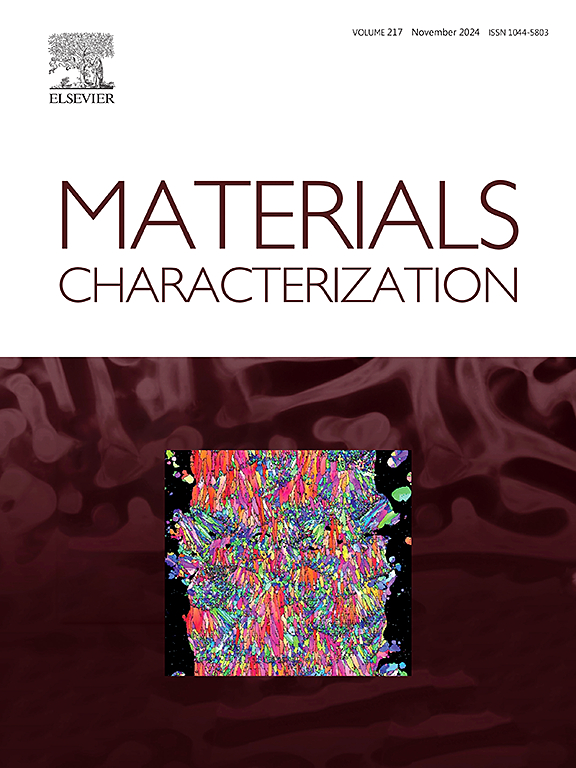线弧定向能沉积Mg-9Gd-3Y-2Zn-0.5Zr合金的组织演变及其与力学性能和腐蚀行为的关系
IF 4.8
2区 材料科学
Q1 MATERIALS SCIENCE, CHARACTERIZATION & TESTING
引用次数: 0
摘要
利用线弧增材制造技术高效整体成形大型复杂部件的Mg-RE(稀土)合金一直备受关注。本文采用线弧定向能沉积(WA-DED)技术制备了新型Mg-9Gd-3Y-2Y-0.5Zr (wt%, GWZ932K)合金部件。综合分析了铸态和热处理试样的显微组织、力学性能和腐蚀行为。结果表明:沉积态合金主要由等轴晶、共晶(Mg, Zn)、共晶(Gd, Y)相、层错(SFs)和富re相组成;试样呈现出粗细晶粒交替分布的层状特征,织构强度低,力学性能各向同性。固溶时效处理(520°C × 8 h + 200°C × 10 h)后,共晶相和sf转变为长周期堆积顺序(LPSO)结构。室温下,合金的极限抗拉强度为279 MPa,屈服强度为141 MPa,伸长率为18.7%。晶界强化和LPSO强化对合金性能的提高起着至关重要的作用。在3.5 wt% NaCl溶液中进行的电化学测试表明,与沉积样品相比,t6处理后的样品具有更强的耐腐蚀性,这可能是由于层状LPSO结构和X相的腐蚀屏障作用。本文章由计算机程序翻译,如有差异,请以英文原文为准。
Microstructure evolution and its correlations with mechanical properties and corrosion behavior of Mg-9Gd-3Y-2Zn-0.5Zr alloy fabricated by wire-arc directed energy deposition
High-efficiency monolithic forming of large and complex components of Mg-RE (rare-earth) alloys using wire-arc additive manufacturing technology has been attracting much attention. In this work, a novel Mg-9Gd-3Y-2Y-0.5Zr (wt%, GWZ932K) alloy component was prepared via wire-arc directed energy deposition (WA-DED) technology. The microstructure, mechanical properties, and corrosion behavior of both the as-built and heat-treated samples were comprehensively analyzed. The results showed that the as-deposited alloy was mainly composed of equiaxed grains, eutectic (Mg, Zn)3(Gd, Y) phases, stacking faults (SFs), and RE-rich phases. The specimen exhibits layered features characterized by alternating distributed coarse grains (CG) and fine grains (FG), low texture strength, and isotropic mechanical properties. After solution-aging treatment (520 °C × 8 h + 200 °C × 10 h), the eutectic phase and SFs transformed into the long-period stacking orders (LPSO) structures. The ultimate tensile strength (UTS) of 279 MPa, yield strength (YS) of 141 MPa, and elongation (EL) of 18.7 % in the TD were obtained at room temperature (RT). Grain boundary strengthening and LPSO strengthening play an essential role in enhancing alloy properties. The electrochemical test was carried out in 3.5 wt% NaCl solution revealed that the T6-treated samples exhibited enhanced corrosion resistance compared to the as-deposited samples, which could be attributed to the corrosion barrier effect of the lamellar LPSO structure and X phase.
求助全文
通过发布文献求助,成功后即可免费获取论文全文。
去求助
来源期刊

Materials Characterization
工程技术-材料科学:表征与测试
CiteScore
7.60
自引率
8.50%
发文量
746
审稿时长
36 days
期刊介绍:
Materials Characterization features original articles and state-of-the-art reviews on theoretical and practical aspects of the structure and behaviour of materials.
The Journal focuses on all characterization techniques, including all forms of microscopy (light, electron, acoustic, etc.,) and analysis (especially microanalysis and surface analytical techniques). Developments in both this wide range of techniques and their application to the quantification of the microstructure of materials are essential facets of the Journal.
The Journal provides the Materials Scientist/Engineer with up-to-date information on many types of materials with an underlying theme of explaining the behavior of materials using novel approaches. Materials covered by the journal include:
Metals & Alloys
Ceramics
Nanomaterials
Biomedical materials
Optical materials
Composites
Natural Materials.
 求助内容:
求助内容: 应助结果提醒方式:
应助结果提醒方式:


